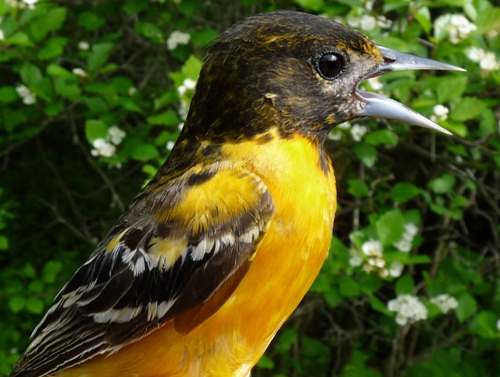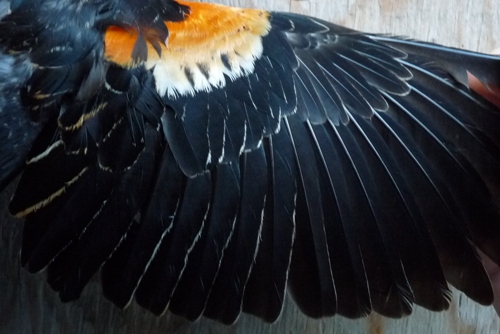|
McGILL BIRD OBSERVATORY |
||||||||||||
Comments or questions are welcome at "mbo AT migrationresearch.org".
Workshop coordinators: Marcel Gahbauer, Brandee Diner Notes: MBO has previously offered three weekend-long banding workshops offering participants an introduction to the challenges of ageing and sexing passerines, usually with a particular focus on one or more groups of birds. This time we took a different approach, partnering with Vanier College to invite Peter Pyle to lead a longer four-day workshop with field practice each morning and a mixture of lectures, discussions, specimen examinations, and quizzes in the afternoons and evenings. It was a very full program, but we all learned a lot from it. Below are a few notes on some of the topics we touched upon in the workshop. Naturally our "textbooks" for the course were Pyle's two volumes of the "Identification Guide to North American Birds" (Slate Creek Press), with a focus primarily on part 1, dealing with passerines and other landbirds. Although most of us in the workshop had used the books extensively as references over the years, having the author present to provide tips on interpretation certainly proved helpful for many species. One particularly useful tip is to compare the extent of moult observed with the ranges presented in the book, and to expect that the degree of feather replacement (i.e. on the scale of limited to extensive) will be consistent within an individual case. In other words, for a species that may replace 0-10 greater coverts in its preformative moult, and may also replace 0-3 tertials, one would expect that an individual which has replaced all its greater coverts would also have three fresh tertials, while one that has replaced only a couple of greater coverts may have retained all of its juvenile tertials. For species that may also replace rectrices in their preformative moult, these can also be factored into this comparison. If the extent of moult appears inconsistent among tracts, it may be a good idea to examine the evidence more closely to see whether any have been assessed incorrectly. Of course there can be a lot of variation among individuals to muddy the picture. This was illustrated well by our experiences with Baltimore Orioles during the workshop. They are commonly banded at MBO, and we thought we had ageing and sexing largely figured out ... until some discussions as a group caused some doubts to arise. Fortunately we caught several individuals of different age/sex classes during the workshop and also reviewed MBO's extensive photo archive of the species, and now feel more confident that we were on the right rack to begin with, but now understand the mechanisms behind the patterns better. One of the most confusing things with Baltimore Orioles is that the extent of black on the head (and to a lesser extent of orange on the breast) is highly variable and overlaps age/sex classes, e.g. some second-year females may be darker than older females; similarly, second-year males can range from having solid black heads like older males to heavily mottled orange/dark heads that are similar or even lighter than those of some females. Eventually we came to the conclusion that the presence of distinctly male-patterned rectrices (i.e. black/orange) appears to be a more reliable indicator of sex than body plumage. Part of the confusion may stem from the timing of moult and the role that hormones play in the deposition of colour in new feathers, e.g. if feathers are replaced when testosterone levels are high, they may come in darker/bolder - but more study is needed on this front, as is the case with many of the subjects we discussed.
The oriole situation reminded us to keep an open mind - what is written in books or other papers represents the best available knowledge at the time of publication, but new discoveries are regularly being made, and there is also a lot of geographic variability to consider for some species. As such, it is good to not get hung up on things seeming "impossible" according to a given reference, but rather to evaluate all of the evidence (and importantly, document these exceptions to the "rules" so that updates to our collective understanding of these species can be discussed and published).
One subject in particular that could benefit from further study and publication is the extent of prealternate moult in various species. For some species the existence of this moult remains unconfirmed, while for others more study is required regarding its typical extent. The Yellow Warbler above appears to show an unusually extensive prealternate moult, having replaced inner secondaries, though Pyle's Part 1 suggests they usually stop at the tertials. Ageing my moult requires an ability to distinguish retained juvenile feathers from formative and alternate feathers, and one of the tricky aspects of that (especially for beginners) is that while for some species there is a distinct colour difference between such feathers, in other species colour "pseudolimits" occur even among basic feathers on older birds, so it is critical to practice looking for differences in feather quality, not just colour. Fortunately in some species there are additional cues to consider. For example, second-year thrushes and thrashers show a distinct "step" among their greater coverts, since the innermost replaced formative feathers are longer than the retained juvenile feathers.
Another useful tip we discussed concerned wrens. They are notoriously difficult to age, in part because moult limits tend to be subtle, and there is minimal difference in appearance between juvenile and adult rectrices. While it has been suggested that the presence of white tips on the greater coverts may be used to help with ageing, there is debate about how reliable this is, especially considering which feathers seem to show this pattern. An alternate approach may be to look at how the pattern of barring on the primaries and secondaries lines up, the theory being that on juveniles these feathers will have grown concurrently and patterns should be aligned, whereas on older birds where the feathers have been replaced sequentially, the pattern could be more jagged.
One of the most vexing species at MBO in spring is Red-winged Blackbird. Males are easy to age - second-year individuals are somewhat mottled, with an orange-tinged shoulder patch, while older males are glossy black with a solid red patch. Females though are quite a different matter! One of the criteria suggested in Part 1 is that second-year females tend to have a whitish chin, while older females have a peach-toned chin ... but virtually all females at MBO have that colour. We suspect that the amount of red in the shoulder increases with age - but that too requires further study. For now, the most reliable ageing criterion appears to be the condition of the underwing coverts, where second-year individuals usually have some retained juvenile feathers in comparatively poor condition compared to others. But this can be a subtle distinction to perceive, so this is a good species on which to pursue study of alternate characteristics that could prove reliable for ageing and may be easier to detect. At the same time though, the fact that the underwing does provide clues to ageing raised the question of whether the same is true for other species, since it is a tract of feathers that is rarely examined on most other birds. There certainly is no lack of research opportunities in this field of study!
Over the course of the workshop, we handled over 100 individuals of over 30 species during banding sessions at MBO and Vanier College, reviewed dozens of specimens of other species (courtesy of the collection maintained by the Canadian Bird Banding Office), and perused hundreds of additional photos on screen. We learned that some species are easier to age and sex than we had thought, thanks to learning new tricks to focus on, but also came to appreciate subtleties of other species that make them more difficult to assess than we had realized. But more importantly, we were reminded on multiple occasions that moult is far from completely understood even in some common species, and that all banders should make an effort to learn more about the species they handle most frequently, and to publish what the results of their research for the benefit of others. We intend to review MBO data for material that we could summarize and share, and look forward to further discussions and discoveries at future workshops.
|


















